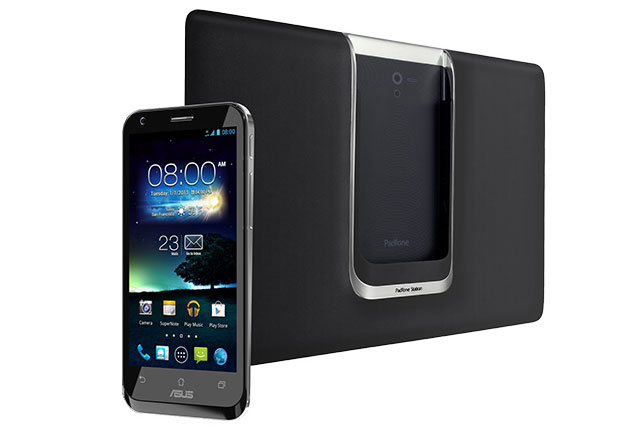“Asus Padfone 2 that transforms to a tablet when you need the
extra real estate”
Qualcomm Snapdragon S4 Pro Krait (Cortex-A15 class)
Quad-Core 1.5GHz with Adreno 320 graphics
4.7″ Super IPS+ 1280×720 Display with Corning® Glass (Phone)10.1″ Super IPS+ 1280×800 Display with Corning® Glass (Tablet)
Front 1.2 Mega-Pixel (Phone) Front 1 Mega-Pixel (Tablet)
2140 mAh Lithium Battery (Phone)
5000 mAh Lithum Battery (Tablet)
135g (Phone)
514g (Tablet)
LTE Support (4G)
WLAN 802.11 a/b/g/n
Bluetooth V4.0
Design
Upon first glace, the Padfone 2 may seem like a generic blocky android phone that just popped out the on-going chain of manufacturers pushing out plain looking devices. Closer inspection reveals the tiny intricate details that ASUS has put into designing the Padfone.
When I first picked up the Padfone 2, it surprisingly felt like a deep and premium device thanks of its slim , tapered aluminium bumper enclosing the borders of the phone. The aluminium bumper feels excellent in my hands, especially when the volume and power buttons are also machined aluminium, further strengthening the premium feel of the device.
The Corning® glass envelopes the entire front side of the phone, which has
the embedded capacitive buttons and even the ASUS branding underneath it. Not covered by the glass is a tiny curved chin at the bottom which melds seamlessly to the bottom. My slight irritation is that the anti-fingerprint coating on the Corning® glass isn’t spectacular by any means, but that’s what good screen protectors are for to remedy this.
The back of the phone may be its biggest uniqueness that is signature only to ASUS. It has a plastic back with circular ridges running around the camera lens. This produces a beautiful light reflection pattern when rotating the phone around. This design choice also can be seen in other premium ASUS products such as the Zenbook ultrabook lineup ASUS offers. Behind also lies a horizontal shiny speaker grill beside the lens and a metallic “Padfone” branding at the bottom.
At the bottom is ASUS’s custom MHL connector and a microphone
The Tablet / Docking Station
and tablet worlds”
The front of the tablet is an almost identical screen to the phone, with same IPS+ technologies and glass used. The key thing to note is the resolution for a 10.1″ tablet (1280×720), which is extremely small for a tablet this size. Other tablets such as the Apple iPad, ASUS transformer prime infinity and Samsung Nexus 10 all have more than 4x the resolution. This might be a deal breaker for some as pixels can obviously be seen at such a low pixel density.
*Note that the docking station is nothing but a paper weight without the Padfone. It can only function when a Padfone is docked in it.
A custom feature called Dynamic Display lies within ASUS customization settings and handles the transition between phone and tablet. What it does is to change the UI from phone to tablet and vice versa, along with closing incompatible apps. Inexperienced or new users may be confused when certain apps force close (including live wallpapers/ launchers) when transitioning between the docking station. There lies a list of which users can choose to bypass the force close caused by Dynamic Display but not closing certain apps during transition may cause compatibility issues.
The Padfone 2’s camera on the back is a 13 Megapixel shooter with a rather wide aperture of F/2.4 and a BSI (Backside Illuminated) sensor that is outsourced from Sony. ASUS has even bundled custom software for operating the camera, including various modes and filters that users can set and adjust as they wish. Some advance controls were also present such as being able to manually choose ISO levels and changing exposure compensation levels.
Panoramic mode in the camera
Other than just taking fast stills, the Padfone can also take decent quality video in several modes, highest quality being 1080P with an easy to edit MP4 format.
*enlarge to see noise clearly
 Battery Life
Battery Life
All the upward peaks on the diagram is actually the dock charging the Padfone directly from its battery. There is even a separate keyboard dock that can be purchased to add on to the already ridiculous battery capacity.
 Sound
Sound
ASUS also have some custom tweaks for their sound, featuring “SonicMaster audio technology” in their speakers. Users will be able to select 5 preset scenarios from the “AudioWizard” app to suite their audio needs. However, the technology is only available for the speakers and not external headphones. Unlike HTC’s way approach for Beats Audio where it is applied universally to all plugged in audio devices.
In my testing, plugging in my in-ear headphones and listening to some music and tried some games. There was no static noise at all which was excellent.
The speaker on the rear of the phone sounds really good. It doesn’t distort much when playing back even when maxing out the volume. In-addition, the position of the speakers are optimal, with little chance of your hand muffling the sound.
The tablet speakers however are only located on one side, holding it in landscape can easily muffle the speakers.
“Exceptional speakers, mediocre software“
Benchmarks
Conclusion
The unique thing about this phone is that it can satisfy 2 needs, a smart phone and a tablet, 2 in one solution that compliments each other without sacrificing additional data plan costs. The specifications on the device is good, no major flaws in any way and since it is so unique, it will steal stares from everyone you encounter.
PROS:
Super IPS+ 720P display
Latest generation of hardware at time of release
shared Data plan for tablet/phone
First class battery life
CONS:
Custom software still needs some refinement
Bloatware pre-installed (easily mitigated with uninstalls)
App incompatibility while transitioning between phone and tablet.

















